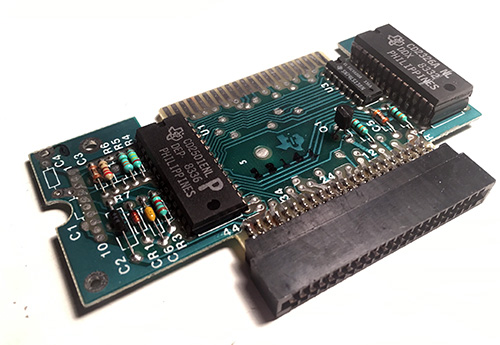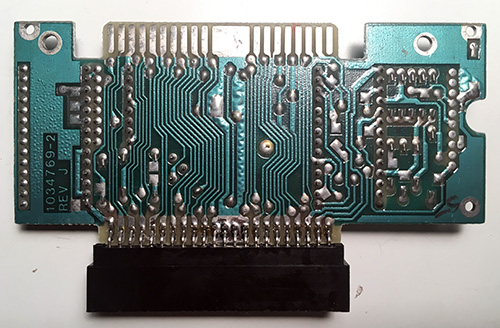The Ware for January 2019 is shown below.
Thanks to Jesse for contributing this handsome retro-ware.
This one should be a cakewalk — I did not blur out the part numbers because I felt like by the time I finished obscuring the ware there wouldn’t be much left for guessing! Instead, I’m just appreciating a retro-ware for what it is — a reminder of a time when not everything could be done in software, and we had to rely on special purpose chips to do even the simplest of things.
I also included a picture of the back side of the board because it illustrates a common problem seen in PCBs from the 80’s — namely, what happens when soldermask is applied directly over tin/lead plating. Tin/lead can be used as an etching barrier; conveniently, once the etch is done, the tin/lead plating doubles as the solderable finish for the PCB. So, if you scrape back the soldermask of the older PCBs like this, you won’t immediately find bare copper: you’ll first encounter a layer of tin/lead plating.
Unfortunately, when the PCB is subject to reflow temperatures (and particularly wave soldering), the entire tin/lead layer liquifies, and excess solder from the pads will flow under the soldermask, creating the wrinkling, ripples and bumps seen under the larger traces.
Modern PCBs still use a tin mask as an etch barrier, but the tin is stripped off entirely before the soldermask is applied (hence the term “SMOBC”, or soldermask on bare copper), and then solder is re-applied to all the pads using a HASL (hot air solder leveling) process (or ENIG, OSP, or whatever finish is required). Seems like a lot of work to apply a finish only to strip it off, but bare copper won’t allow solder to seep underneath the soldermask, so it’s worth it.


Appears to be a speech synthesizer. The CD25015 is a synthesizer. The other is a ROM. Googling the parts leads to a page describing it as a speech synthesizer :) There’s an interesting write up here: http://www.unige.ch/medecine/nouspikel/ti99/speech.htm
A google of the part number of the rightmost IC brings up this page: http://www.unige.ch/medecine/nouspikel/ti99/synth.htm.
It looks like this is a speech synthesizer module for a TI-99 computer.
There’s quite a detailed look into the module and its operation here: http://www.unige.ch/medecine/nouspikel/ti99/speech.htm.
Apparently this is some kind of speech synthesizer. A “Speech synthesizer CD25015-NL”, to be more precise.
See http://www.unige.ch/medecine/nouspikel/ti99/speech.htm for more details, if I’m not mistaken.
ti 99 speech synthesizer!
TI-99/4A Speech Synth!
btw I’m a fan of the toy “Speak & Spell” from Texas Instruments, and it’s italian localized version “Grillo parlante” which translates to “talking cricket” :D
I am wondering if the english version it’s hard to understand even to a person who speaks English as native language…
The Speak N Spell always sounded to me like a very bored robot who was speaking by inhaling instead of exhaling if you follow me. I’d be fascinated to hear what it sounded like in Italian!
https://youtu.be/suz0v9mLHg4 ;)
Love the two DIPs stacked on top of each other!
Oh, I agree with all about this being a speech synthesizer for the TI/99 computer. I’d never seen the board before, I but would recognize the outside. It came in a little side-car that clamped onto the side of the computer, then passed the bus through to the other side of the box where you could clamp on additional extension boxes.
I recall playing Alpiner using this on a friend’s computer, and it would spout out warnings about falling objects: “Look out!”
I agree that It’s a speech synthesizer
The stacked DIP confirms that. And the design looks kinda dated
Amazing how speech synth boards have been made largely obsolete by AIG kits, amazon alexa apis, and smaller low cost full featured systems on a chip. Seems like that other chip was used in laser disc applications as well.